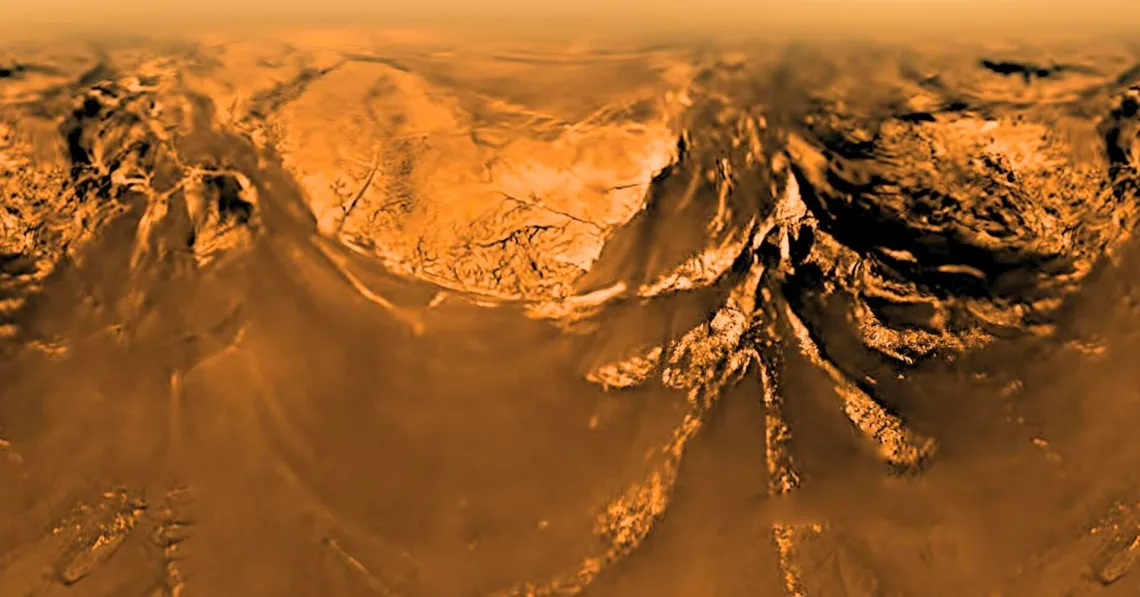Saturn’s Largest Moon Most Likely Uninhabitable

This image shows a flattened (Mercator) projection of the Huygens probe's view of Saturn’s moon Titan from 10 kilometers altitude. The images that make up this view were taken on Jan. 14, 2005, with the descent imager/spectral radiometer onboard the European Space Agency’s Huygens probe.
ESA/NASA/JPL/UArizona
A study led by Western astrobiologist Catherine Neish shows the subsurface ocean of Titan—the largest moon of Saturn—is most likely a non-habitable environment, meaning any hope of finding life in the icy world is dead in the water.
This discovery means it is far less likely that space scientists and astronauts will ever find life in the outer solar system, home to the four 'giant' planets: Jupiter, Saturn, Uranus and Neptune.
"Unfortunately, we will now need to be a little less optimistic when searching for extraterrestrial lifeforms within our own solar system," said Neish, an Earth sciences professor. "The scientific community has been very excited about finding life in the icy worlds of the outer solar system, and this finding suggests that it may be less likely than we previously assumed."
The identification of life in the outer solar system is a significant area of interest for planetary scientists, astronomers and government space agencies like NASA, largely because many icy moons of the giant planets are thought to have large subsurface oceans of liquid water. Titan, for example, is thought to have an ocean beneath its icy surface that is more than 12 times the volume of Earth's oceans.
"Life as we know it here on Earth needs water as a solvent, so planets and moons with lots of water are of interest when looking for extraterrestrial life," said Neish, a member of Western's Institute for Earth and Space Exploration.
In the study, published in the journal Astrobiology, Neish and her collaborators attempted to quantify the amount of organic molecules that could be transferred from Titan's organic-rich surface to its subsurface ocean, using data from impact cratering.
Comets impacting Titan throughout its history have melted the surface of the icy moon, creating pools of liquid water that have mixed with the surface organics. The resulting melt is denser than its icy crust, so the heavier water sinks through the ice, possibly all the way to Titan's subsurface ocean.
Using the assumed rates of impacts on Titan's surface, Neish and her collaborators determined how many comets of different sizes would strike Titan each year over its history. This allowed the researchers to predict the flow rate of water carrying organics that travel from Titan's surface to its interior.
Neish and the team found the weight of organics transferred in this way is quite small, no more than 7,500 kg/year of glycine—the simplest amino acid, which makes up proteins in life. This is approximately the same mass as a male African elephant. (All biomolecules, like glycine, use carbon—an element—as the backbone of their molecular structure.)
"One elephant per year of glycine into an ocean 12 times the volume of Earth's oceans is not sufficient to sustain life," said Neish. "In the past, people often assumed that water equals life, but they neglected the fact that life needs other elements, in particular carbon."
Other icy worlds (like Jupiter's moons Europa and Ganymede and Saturn's moon Enceladus) have almost no carbon on their surfaces, and it is unclear how much could be sourced from their interiors. Titan is the most organic-rich icy moon in the solar system, so if its subsurface ocean is not habitable, it does not bode well for the habitability of other known icy worlds.
"This work shows that it is very hard to transfer the carbon on Titan's surface to its subsurface ocean—basically, it's hard to have both the water and carbon needed for life in the same place," said Neish.
More information: Catherine Neish et al, Organic Input to Titan's Subsurface Ocean Through Impact Cratering, Astrobiology (2024). DOI: 10.1089/ast.2023.0055
